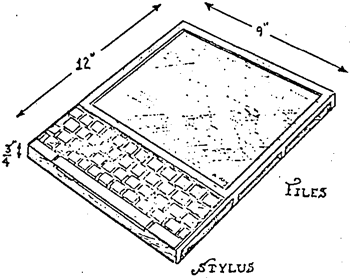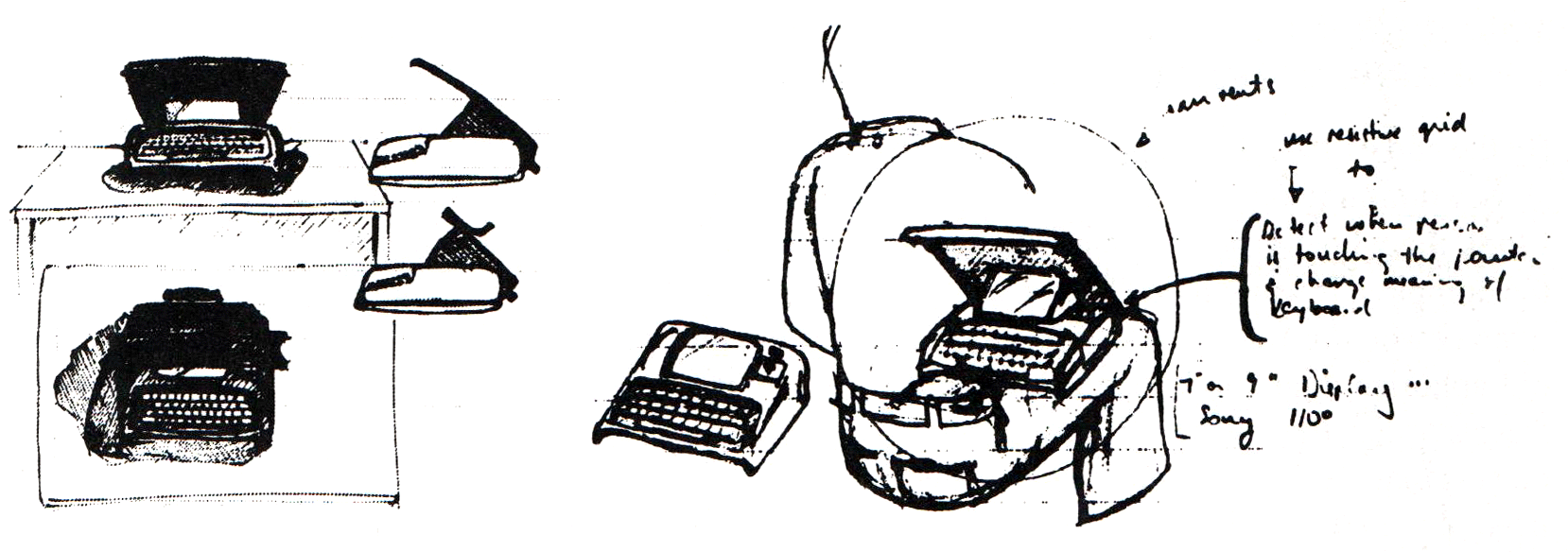In 1972 Alan Kay published a paper called "A Personal Computer for Children of All Ages". In it's pages Kay offers the first description of a portable computer, what he calls the DynaBook. What makes this document so remarkable is that the computer it describes is shockingly modern. Despite being nearly 50 years old the DynaBook is depicted as essentially a tablet computer. What's more, Kay envisioned DynaBook as a user friendly computer that could be used by anyone, from children up to computer experts.

The most widely circulated sketch of the DynaBook shows it as a flat slate 12" x 9" slate with a screen and keyboard on its surface. I/O ports, some type of removable storage, and a holder for a stylus would be built into the sides of the computer's case. But Kay is quick to point out that the computer need not be bound to that specific design, rather the sketch was given as one possible form factor for the DynaBook. In Kay's view a personal computer had to be portable and easy to use, the keyboard-and-screen design was just one way to accomplish that goal.
"Once one has gotten used to the idea of no moving parts, he is ready for the idea of no keyboard at all! Suppose the display panel covers the full extent of the notebook surface. Any keyboard arrangement one might wish can then be displayed anywhere on the surface.
…
The bottom portion of the display panel can be textured in various ways to permit touch typing. This arrangement allows the font in which one is typing to be shown on the keys, special characters can be windowed, and user identifiers can be selected with one touch."
~Alan Kay, A Personal Computer for Children of All Ages
So scratching just below the surface Kay does indeed describe a tablet computer almost perfectly. The idea of a textured screen definitely didn't take off, but Kay correctly foresaw that a keyboard could be removed from the equation altogether. On screen keyboards on smart phones and tablets today look a lot like what Kay describes, a keyboard is simply displayed on a portion of the screen as needed. He even identifies the flexibility of this type of system. Since the keyboard is just another image displayed on screen you aren't beholden to any one layout or look.
The futuristic hardware design is just part of what makes Kay's writing shocking. He brings things to another level by claiming that the DynaBook could be produced using 1972 technology, and that a mass produced DynaBook could be sold for under $500 dollars. Today that has become possible, cheap consumer tablets are readily available. But that was definitely not the case in 1972. Microprocessors were still in their infancy, flat panel displays weren't very much further along in their development. Kay wouldn't build a tablet in the 70s, but the idea of the DynaBook would serve as a goalpost for his future work.
A few years later, in 1976, Kay took another stab at designing a practical DynaBook. This redesign would eventually lead to the development of the Xerox NoteTaker. Kay's first drawings of what the NoteTaker could be show a more practical attempt at designing a portable computer. This later design drops the slate form factor in favor of something more akin to an actual laptop. The large touchscreen was replaced with a more modest size display, but they keyboard remained relatively unchanged. Kay also sketched the NoteTaker with a folding lid that would cover and protect the device.

While the NoteTaker did materialize the finished prototypes were vastly different from Kay's initial design. These prototypes were some of the first luggable computers, weighing in the neighborhood of 50 pounds. A far cry from the DynaBook concept, and not exactly what Kay had in mind. Ultimately we wouldn't get cheap and portable computers for years to come, but Kay's work did plant the seed of the idea.
You can read Alan Kay's "A Portable Computer for Children of All Ages" here: https://www.mprove.de/visionreality/media/kay72.html.
To learn more about the history of portable computing listen to my episode on the topic:
